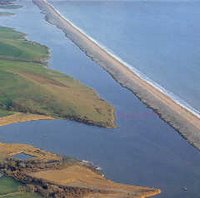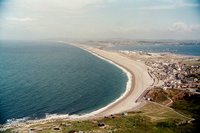Chesil Beach and Portland


Thomas Hardy called the Isle of Portland, ‘the Gibraltar of Wessex’, and like its more southerly doppelganger, the Isle of Portland is connected to the mainland. To its west lies Chesil Beach, a shingle bar several miles long, and up to 40 feet high in places.
The sea has piled up Chesil Beach in such a way as to grade the pebbles and stones that make up the beach; the nearer Portland, the bigger the pebbles. It is said that a fisherman from these shores can tell exactly where he is even when landing in the dark, by the size of the stones at his feet.
Walking along the beach here is a laborious ‘one forward and two back’ affair; walking along the cables that lie lengthwise on the bar is the only way to proceed without exhaustion setting in long before the 7 mile beach terminates under the cliffs of Burton Bradstock.
Behind the bar is a sheet of water, usually mentioned in guidebooks as ‘ brackish’ and known as the Fleet. At one end lies Abbotsbury Swannery, the long necks of mute swans waving like so much white corn in a windswept field.
High above Abbotsbury is a long ridge that begins north of Weymouth, Victorian watering hole, now a minor port and holiday resort. The Hardy Monument sticks up from the western end of Black Down (mentioned in Hardy as Black’n), like a landlocked lighthouse. The monument commemorates Hardy the admiral in Nelson’s fleet, rather than the local author, Thomas Hardy, whose monuments lie nearer to his birthplace, Higher Bockhampton, north of Dorchester, and in Poets’ Corner in Westminster Abbey in London.
Most of Portland has been quarried for Purbeck marble, used by Sir Christopher Wren to build St. Paul’s Cathedral in the capital, the rest of the ‘isle’ is occupied by a naval base, and the dwellings that make up Portland; with the bit that pushes insistently into the English Channel known as Portland Bill.
Robert L. Fielding

0 Comments:
Post a Comment
Visit My Website<< Home